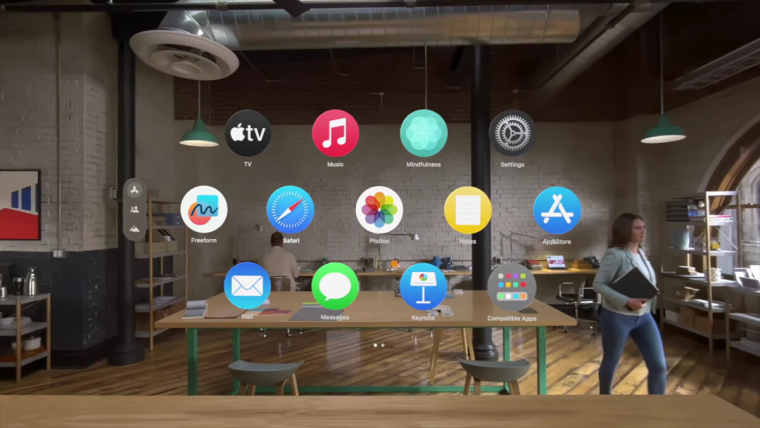
Apple introduced today its first spatial computing device – the revolutionary Vision Pro headset. Priced at $3,499, the device uses technology that scales digital content beyond a traditional screen to blend with the physical world.
The Vision Pro features Apple’s own M2 and R1 chips to deal with its intense processing requirements and real-time content rendering.
The ultra-high resolution micro-OLED displays pack 23 million pixels across two screens to create an expansive virtual environment.
Meanwhile, advanced Spatial Audio provides a 3D sound that matches the virtual space.
The headset runs on the brand new visionOS, the first spatial operating system from Apple (AAPL). This allows apps to appear limitlessly alongside each other. Vision Pro’s infinite virtual screen can transform any space into a personal theater.
With its 3D camera, Vision Pro lets users relive memories with Spatial Audio that places them right at the moment. FaceTime calls become visually immersive with participants displayed as life-size tiles with Spatial Audio.
The device was also designed with privacy as a top priority. Introducing Optic ID, the Vision Pro can securely authenticate users without storing data. The device’s eye tracking information, used to complete the authentication process, is not shared.
Tim Cook Says That the Apple Vision Pro is Years Ahead of Anything Created
In regards to the new product, Tim Cook, the CEO of the Cupertino-based tech firm, said: “Today marks the beginning of a new era for computing”. He went on by stating that the Vision Pro introduces people to spatial computing and was “built upon decades of Apple innovation”.
“Vision Pro is years ahead and unlike anything created before — with a revolutionary new input system and thousands of groundbreaking innovations. It unlocks incredible experiences for our users and exciting new opportunities for our developers.”, the tech leader continued.
Meanwhile, Mike Rockwell, the VP of the Technology Development Group at Apple, commented: “Through a tight integration of hardware and software, we designed a standalone spatial computer in a compact wearable form factor that is the most advanced personal electronics device ever”.
The Vision Pro’s breakthrough design utilizes three-dimensionally formed glass elements to give digital content a sense of presence. The device’s eye-tracking system gauges a user’s point of focus for intuitive input.
This new gear from Apple promises to transform work, play, and communications by seamlessly combining the virtual and physical worlds, though the average consumer may encounter a roadblock to afford it.
Vision Pro Price Tag May Limit the Device’s Success for Now – Is a ‘Light’ Version Coming?
Audience reaction when Apple announced the $3500 price for the headset 😭 pic.twitter.com/GuGUFbN08A
— TTI (@TikTokInvestors) June 5, 2023
The launch of Vision Pro heralds a potential inflection point for personal technology, though early adoption will likely be limited at this point to niche audiences, large corporations, and rich households and individuals who can afford such an expensive device.
Early reviews have praised Vision Pro’s unprecedented technological capabilities but warned consumers may have trouble visualizing practical use cases. Experts in the tech industry agree that this first version of an AR/VR product from Apple may be targeting companies first rather than consumers.
The “Pro” label can be considered an indication that “lighter” versions of the product could soon be released to the market, probably once enough applications and games have been developed for the device.
Also read: Meta Platforms Shares Blueprint for AR/VR Hardware with Employees
Apple is encouraging developers to build innovative spatial computing apps optimized for the headset. To this end, the firm has partnered with Unity Software to create the required platform to design and launch applications for the device.
Apple’s spatial computing ambitions hinge on Vision Pro’s ability to define an entirely new product category. The company will need to demonstrate compelling real-world scenarios that justify the premium price tag and convince consumers of the value of owning a spatial computing device.
This has not been a difficult task for Apple in the past as they did manage to mass-market their wearables – i.e. the Apple Watch – despite them not being the most useful consumer electronics device from a practical standpoint.
Related Articles:
